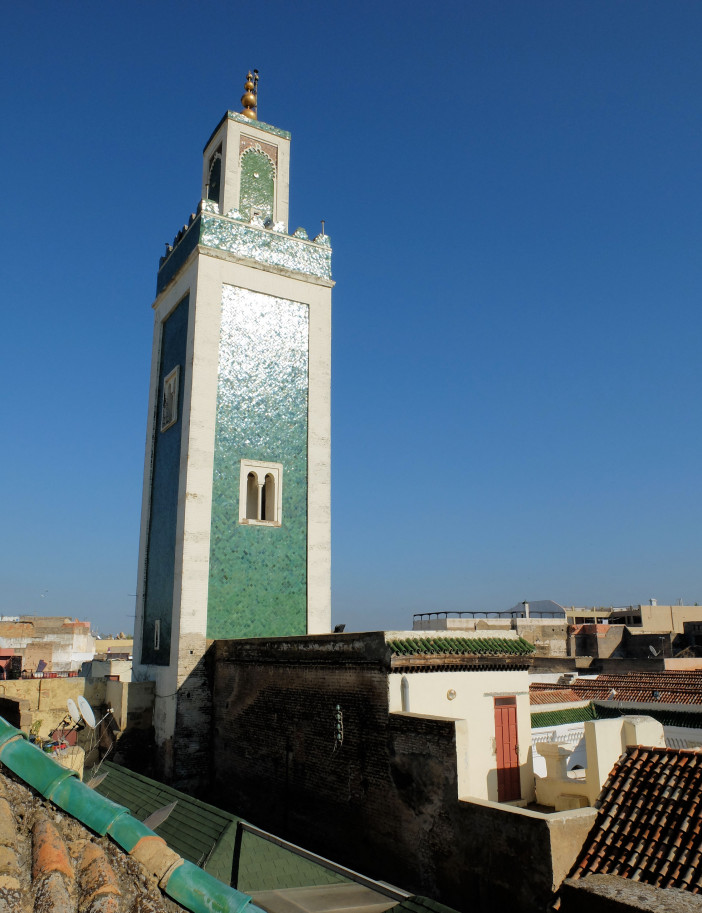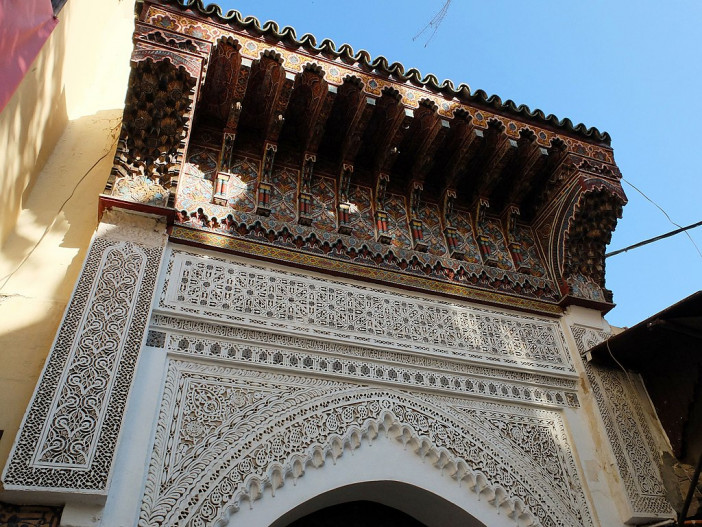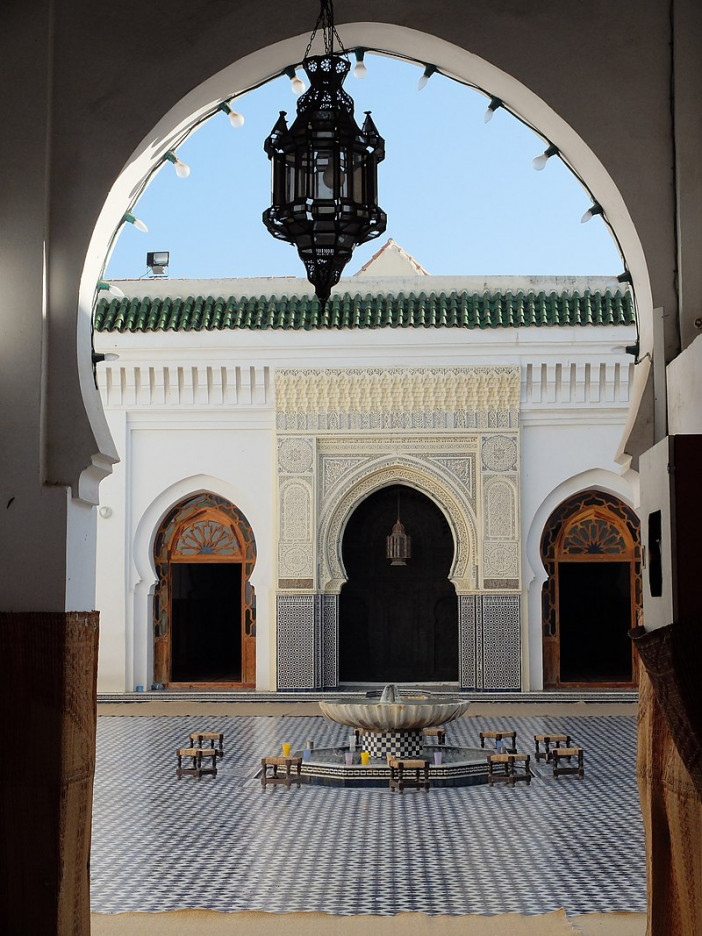Grand Mosque of Meknes
History
The mosque is situated in the heart of the old city and anchors its most significant commercial and religious district, which includes the city's main souq streets (also known as the qaysariyya or kissaria[3]) and its major historic madrasas, all of which are situated close to the mosque. This is similar to many grand mosques in other Moroccan cities (for example, Ben Youssef Mosque in Marrakech or al-Qayrawiyyin in
The Almoravid dynasty, which ruled in the 12th century, is thought to have constructed the mosque.
It underwent significant restoration and expansion under the Almohad caliph Muhammad al-Nasir (ruled 1199–1213), who, among other things, diverted a new source of water to it from a source 9 kilometres south of the city.
From the Almohad period the mosque also preserves a large and ornate copper chandelier similar in style to the great Almohad chandelier in the al-Qarawiyyin Mosque in Fes.
The mosque underwent major restorations again in the 14th century, under the Marinids.
The minaret was rebuilt, among other things, after it had previously collapsed and killed 7 worshipers.
The primary madrasas of the city, which tended to revolve around the mosque, were specifically built by the Marinids. Among them were three madrasas constructed by Sultan Abu el-Hassan: the adjacent Bou Inania Madrasa (established in 1336) and Madrasa al-Qadi and Madrasa Shuhud. Abu el-Hassan also made arrangements for a number of Islamic scholars to give lectures at the mosque and added a library to it.
The Alaouite sultans also oversaw additional renovations and alterations. The mihrab area was renovated by Moulay Ismail (who ruled from 1672 to 1727), who also gave the mosque its modern minbar, anaza, and several of the fountains in its courtyard. The current minaret was constructed by Moulay Mohammed ben Abdallah (1757–1790), who was also the ruler at the time.
Urban and Architectural
The mosque's shape and design are characteristic of traditional mosques in Morocco or North Africa. It is made up of a large interior prayer hall with a floor area of about 3500 square meters.The main area (south of the courtyard) is divided into nine aisles by rows of arches that run parallel to the southern/southeastern wall (also known as the qibla wall, the wall in the direction of prayer). The arches and columns are plain, and the floor is covered with mats.
A central "nave" that is significantly more conspicuous than the rest of the space around it leads to the mihrab and runs roughly north-to-south across the center of the prayer hall. It is perpendicular to the southern wall (a niche symbolizing the direction of prayer). The mihrab itself was renovated under the reign of Moulay Ismail and is embellished with carved and painted stucco (ruled 1672–1727). This era also includes the minbar (mosque pulpit) in the area.
A wide courtyard (sahn) with a central fountain to aid in ablutions can be seen in the mosque's northern wing. The prayer hall and its arches are located on three sides of the courtyard, which is covered in zellij tiles. One of the mosque's main entrances is located on the courtyard's northern side. Any of the surrounding arches can be used to enter the prayer hall from the courtyard, but the middle arch on the southern side of the courtyard, directly across from the mosque entrance and matching the archway of the central nave leading to the mihrab, is adorned with lavish carved and painted stucco.
The anaza, an elaborate wooden screen with mihrab designs that serves as an outdoor or "summer" mihrab for prayers said in the courtyard, also covers its opening. The anaza is lavishly carved and resembles anazas from the Marinid era, such the one at the Qarawiyyin Mosque in Fes, which was finished in 1290, but it is dated to 1715, indicating that it was made during Moulay Ismail's rule.
The mosque's facade is largely hidden by the nearby structures and the old city's dense urban fabric. The mosque has 11 gates, with Bab al-Kutub (Gate of the Books) being one of the primary entrances to the west. Rich stucco ornamentation and a canopy made of painted and sculpted wood surround 210. The mosque may be identified from above by its rows of sloping green-tiled roofs as well as by its sizable and imposing minaret.
During the tenure of the Alaouite ruler Moulay Mohammed ben Abdallah, the current minaret was built (ruled 1757–1790).
The four facades of the minaret are covered with a surface of gleaming green faience tiles, which are a distinguishing feature of minarets in Meknes. Near the base of the minaret, overlooking the courtyard of the mosque, is a dar al-muwaqqit or traditional restaurant.
Description
References
Ramirez, Francis; Rolot, Christian (2004). Meknès, cité impériale. Courbevoie (France): ACR Édition. p. 134.
Métalsi, Mohamed; Tréal, Cécile; Ruiz, Jean-Michel (1999). Les villes impériales du Maroc. Paris: Terrail.
The Rough Guide to Morocco (11th ed.). Rough Guides. 2016. p. 202.
Touri, Abdelaziz; Benaboud, Mhammad; Boujibar El-Khatib, Naïma; Lakhdar, Kamal; Mezzine, Mohamed (2010). Le Maroc andalou : à la découverte d'un art de vivre (2 ed.). Ministère des Affaires Culturelles du Royaume du Maroc & Museum With No Frontiers. ISBN 978-3902782311.
El Khammar, Abdeltif (2005). Mosquées et oratoires de Meknès (IXe-XVIIIe siècle): géographie religieuse, architecture et problème de la Qibla. Université Lumière-Lyon 2.
Details
Location
Meknes, Morocco
Owners
Sultan Abu el-Hassan
Year of Build
12th century (Almoravid period)
Drawings
Map
History
The mosque is situated in the heart of the old city and anchors its most significant commercial and religious district, which includes the city's main souq streets (also known as the qaysariyya or kissaria[3]) and its major historic madrasas, all of which are situated close to the mosque. This is similar to many grand mosques in other Moroccan cities (for example, Ben Youssef Mosque in Marrakech or al-Qayrawiyyin in
The Almoravid dynasty, which ruled in the 12th century, is thought to have constructed the mosque.
It underwent significant restoration and expansion under the Almohad caliph Muhammad al-Nasir (ruled 1199–1213), who, among other things, diverted a new source of water to it from a source 9 kilometres south of the city.
From the Almohad period the mosque also preserves a large and ornate copper chandelier similar in style to the great Almohad chandelier in the al-Qarawiyyin Mosque in Fes.
The mosque underwent major restorations again in the 14th century, under the Marinids.
The minaret was rebuilt, among other things, after it had previously collapsed and killed 7 worshipers.
The primary madrasas of the city, which tended to revolve around the mosque, were specifically built by the Marinids. Among them were three madrasas constructed by Sultan Abu el-Hassan: the adjacent Bou Inania Madrasa (established in 1336) and Madrasa al-Qadi and Madrasa Shuhud. Abu el-Hassan also made arrangements for a number of Islamic scholars to give lectures at the mosque and added a library to it.
The Alaouite sultans also oversaw additional renovations and alterations. The mihrab area was renovated by Moulay Ismail (who ruled from 1672 to 1727), who also gave the mosque its modern minbar, anaza, and several of the fountains in its courtyard. The current minaret was constructed by Moulay Mohammed ben Abdallah (1757–1790), who was also the ruler at the time.
Urban and Architectural
The mosque's shape and design are characteristic of traditional mosques in Morocco or North Africa. It is made up of a large interior prayer hall with a floor area of about 3500 square meters.The main area (south of the courtyard) is divided into nine aisles by rows of arches that run parallel to the southern/southeastern wall (also known as the qibla wall, the wall in the direction of prayer). The arches and columns are plain, and the floor is covered with mats.
A central "nave" that is significantly more conspicuous than the rest of the space around it leads to the mihrab and runs roughly north-to-south across the center of the prayer hall. It is perpendicular to the southern wall (a niche symbolizing the direction of prayer). The mihrab itself was renovated under the reign of Moulay Ismail and is embellished with carved and painted stucco (ruled 1672–1727). This era also includes the minbar (mosque pulpit) in the area.
A wide courtyard (sahn) with a central fountain to aid in ablutions can be seen in the mosque's northern wing. The prayer hall and its arches are located on three sides of the courtyard, which is covered in zellij tiles. One of the mosque's main entrances is located on the courtyard's northern side. Any of the surrounding arches can be used to enter the prayer hall from the courtyard, but the middle arch on the southern side of the courtyard, directly across from the mosque entrance and matching the archway of the central nave leading to the mihrab, is adorned with lavish carved and painted stucco.
The anaza, an elaborate wooden screen with mihrab designs that serves as an outdoor or "summer" mihrab for prayers said in the courtyard, also covers its opening. The anaza is lavishly carved and resembles anazas from the Marinid era, such the one at the Qarawiyyin Mosque in Fes, which was finished in 1290, but it is dated to 1715, indicating that it was made during Moulay Ismail's rule.
The mosque's facade is largely hidden by the nearby structures and the old city's dense urban fabric. The mosque has 11 gates, with Bab al-Kutub (Gate of the Books) being one of the primary entrances to the west. Rich stucco ornamentation and a canopy made of painted and sculpted wood surround 210. The mosque may be identified from above by its rows of sloping green-tiled roofs as well as by its sizable and imposing minaret.
During the tenure of the Alaouite ruler Moulay Mohammed ben Abdallah, the current minaret was built (ruled 1757–1790).
The four facades of the minaret are covered with a surface of gleaming green faience tiles, which are a distinguishing feature of minarets in Meknes. Near the base of the minaret, overlooking the courtyard of the mosque, is a dar al-muwaqqit or traditional restaurant.
Description







